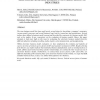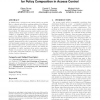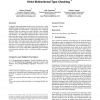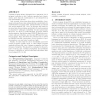45 search results - page 7 / 9 » Non-Interference in Constructive Authorization Logic |
ECIS
2004
13 years 8 months ago
2004
The term business model has been used loosely several times for describing a company's strategies, revenue model, processes and overall business logic both by researchers and...
POPL
1998
ACM
13 years 11 months ago
1998
ACM
abstractions, such as closures, tuples, and user-defined abstract data types. The type system ensures that well-typed programs cannot violate these abstractions. In addition, the ...
CCS
2007
ACM
14 years 1 months ago
2007
ACM
In defining large, complex access control policies, one would like to compose sub-policies, perhaps authored by different organizations, into a single global policy. Existing po...
TLDI
2005
ACM
14 years 27 days ago
2005
ACM
Completely annotated lambda terms (such as are arrived at via the straightforward encodings of various types from System F) contain much redundant type information. Consequently, ...
STOC
2001
ACM
14 years 7 months ago
2001
ACM
Optimal program slicing determines for a statement S in a program whether or not S affects a specified set of statements, given that all conditionals in are interpreted as non-d...




